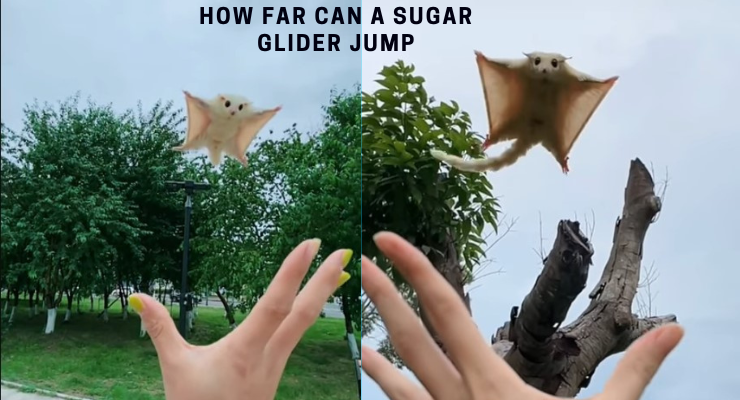Sugar Glider Noises Chirping VS Barking Communication Guide
Did you know that sugar gliders have their own unique language? These adorable creatures communicate through a fascinating array of vocalizations, using their noises to convey different messages. Understanding sugar glider noises is crucial if you want to truly connect with these little marsupials and decipher their behavior.
From chirping to barking, each sound they make has a specific meaning. Learning how to differentiate between these common noises can provide valuable insights into your sugar glider’s emotions and needs. Happy noises, for instance, signify contentment and joy, while the occasional hissing sound might indicate fear or discomfort.
Following this article, we will discuss the Sugar Glider Noises Chirping VS Barking Communication Guide. By tuning in to their soundscape, you can forge a stronger bond with your furry friend and ensure their well-being. So, let’s dive into the world of sugar glider sounds and discover how this unique form of communication enhances our connection with them.
Importance of Sugar Glider Vocalizations
Vocalizations play a crucial role in the lives of sugar gliders, enabling them to express their emotions and communicate their needs effectively. Understanding these vocal cues is essential for promoting their overall well-being and ensuring a harmonious environment for these adorable creatures.
Sugar gliders have a unique way of singing, using various vocalizations to convey different messages. By paying attention to their singing, owners can decipher what their furry friends are trying to tell them. Here’s why understanding sugar glider vocalizations is so important:
- Expressing Emotions and Needs: Sugar gliders use vocalizations as a means of expressing their emotions. From soft chirping sounds to louder barks, each noise carries a specific meaning. By recognizing these vocal cues, owners can better understand when their sugar glider is happy, scared, or in need of attention.
- Promoting Well-being: When we respond appropriately to our sugar gliders’ vocalizations, we contribute to their overall well-being. By addressing their needs promptly and providing comfort when they’re distressed, we create an environment that fosters happiness and contentment.
- Preventing Health Issues: Distress calls from sugar gliders can indicate potential health problems or discomfort. By being attentive to these vocal signals, owners can identify issues early on and seek appropriate veterinary care if needed. This proactive approach helps prevent more serious health complications down the line.
- Resolving Conflicts: Just like humans, sugar gliders may experience conflicts within their social groups or even with other pets in the household. Vocalizations serve as a form of communication during such instances of conflict or territorial disputes. By interpreting these sounds correctly, owners can intervene and help resolve conflicts peacefully.
Understanding the significance of sugar glider singing and vocalizations allows us to establish stronger bonds with our furry companions while ensuring their emotional well-being remains intact. So, the next time your sugar glider starts to sing, take a moment to listen and respond accordingly. After all, their unique vocalizations are their way of speaking to us!
Decoding Chirping and Barking in Sugar Gliders

Chirping and barking are distinct sounds made by sugar gliders. Each noise carries a different meaning and purpose, playing significant roles in their social interactions.
Identifying chirps versus barks is key to understanding their communication. Here’s a breakdown of what you need to know:
- Chirping: When sugar gliders chirp, it usually indicates a positive state of mind. It’s their way of expressing happiness or contentment. Happy chirping is often heard when they’re playing, exploring their surroundings, or interacting with other gliders.
- Barking: On the other hand, sugar glider barks serve as an alarm or warning signal. They use this sound to communicate potential danger or threats in their environment. Excessive barking may indicate that something has startled or agitated them.
To better comprehend their vocalizations, it’s important to pay attention to accompanying behaviors:
- Crabbing sound: Sometimes, sugar gliders produce a crabbing sound along with their barks. This high-pitched noise resembles the hissing of a crab and signifies fear or aggression towards perceived threats.
- Scratching and abnormal digging behavior: If you notice your sugar glider engaging in excessive scratching or abnormal digging behavior while making these sounds, it could be an indication of stress or discomfort.
Understanding the nuances between chirps and barks will help you decipher your sugar glider’s messages more effectively. By paying close attention to their vocalizations and observing associated behaviors, you can ensure better communication with your furry friend.
Remember that each sugar glider may have its own unique way of communicating, so take the time to familiarize yourself with your pet’s specific vocalizations and behaviors for a stronger bond.
Meaning Behind Sugar Glider Chirping Sounds
Chirping sounds made by sugar gliders hold significant meaning and can reveal important information about their emotions, intentions, and communication. Understanding these chirps can help decipher the specific message being conveyed. Let’s explore the different meanings behind sugar glider chirping sounds:
- Contentment, Happiness, or Excitement:
- Chirping often indicates that a sugar glider is content, happy, or excited.
- It signifies their overall well-being and satisfaction in their environment.
- Mating Call:
- During the breeding season, chirping can serve as a mating call for sugar gliders.
- It helps attract potential mates and establish reproductive connections.
- Territorial Boundaries and Food Sources:
- Chirps may also act as signals to mark territorial boundaries among sugar gliders.
- They communicate ownership of certain areas within their habitat.
- Chirping can indicate the discovery of food sources or alert others to available nourishment.
Understanding the context in which chirping occurs is crucial for interpreting its precise meaning. By observing other behavioral cues accompanying the chirps, such as body language or interaction with other sugar gliders, one can gain a deeper understanding of what the chirps signify.
Interpreting Sugar Glider Barking: What It Indicates

Barking in sugar gliders is a significant form of communication that can convey various messages. Understanding the meaning behind their barks is crucial for effectively addressing their concerns and ensuring their well-being. Here are some key points to consider when interpreting sugar glider barking:
- Barking typically signifies fear, alarm, or aggression in sugar gliders. When they feel threatened or perceive unfamiliar situations, barking becomes their way of expressing discomfort or warning others.
- It’s important to recognize the triggers that can lead to barking in sugar gliders. Perceived threats from predators or sudden changes in their environment may provoke them to bark as a defensive response.
- In certain circumstances, barks may indicate discomfort or pain experienced by sugar gliders. It could be a sign of injury, illness, or even stress caused by factors such as improper diet or inadequate living conditions.
- By observing the context and behavior accompanying the barks, you can gain insights into what your sugar glider is trying to communicate. Pay attention to their body language, such as flattened ears or aggressive postures, which can provide additional clues about their emotional state.
Understanding the signs and meanings behind sugar glider barking allows you to respond appropriately and address any underlying issues they may be experiencing. By creating a safe and comfortable environment for your furry friends, you can help alleviate their fears and ensure their overall well-being.
Remember that each sugar glider is unique, so it’s essential to observe your pet’s specific behaviors and consult with an experienced veterinarian if you have concerns about their health or behavior.
How to Interpret Your Sugar Glider’s Noises
Observing your sugar glider’s vocal patterns and body language together can help you better understand their noises. By spending time with them, you’ll become more attuned to their unique communication style.
Pay close attention to the frequency, duration, and intensity of their noises. These factors can provide valuable clues about what your sugar glider is trying to convey. Context is key in interpreting their vocalizations, so consider the situation they are in when making sense of their sounds.
Learning from experienced sugar glider owners or consulting professionals can greatly enhance your understanding. Seek advice from those who have spent time deciphering these adorable creatures’ language. Their insights can offer valuable guidance on interpreting different noises and behaviors.
To truly interpret your sugar glider’s individual vocalizations, it’s essential to develop a unique bond with them. Building a strong relationship will enable you to recognize the subtleties in their sounds and understand what each noise means for your specific pet.
By following these steps and honing your interpretation skills, you’ll be able to communicate more effectively with your sugar glider and strengthen the bond between you both. Remember that practice makes perfectBarks, and other vocal expressions.
So take the time to observe, listen closely, seek guidance from experts or experienced owners, and build that special connection with your furry friend. Soon enough, you’ll become an expert at interpreting your sugar glider’s noises!
Differentiating Between Chirping and Barking in Sugar Gliders
Chirping and barking are two distinct sounds that sugar gliders make to communicate. Understanding the differences between these noises can help you interpret your pet’s emotions and needs.
- Chirping is a melodic, high-pitched, and rhythmic sound. It often resembles a series of short, musical notes. This pleasant chirping is usually associated with positive emotions such as contentment or excitement.
- On the other hand, barking sounds more harsh, repetitive, and intense compared to chirping. It can be described as a rapid succession of sharp vocalizations. Barks typically indicate negative emotions like fear, aggression, or distress.
- By paying attention to the distinct characteristics of each sound, you can differentiate between chirps and barks in sugar gliders. Chirps are generally linked to positive experiences while barks signify something negative.
Understanding your sugar glider’s vocal cues is essential for their well-being. Here’s a quick guide on how to interpret their communication:
- Listen for melodic and rhythmic sounds resembling short musical notes – these are chirps.
- If you hear rapid and repetitive sharp vocalizations, it is likely your sugar glider is barking.
- Note the context in which the sounds occur: chirps are often associated with positive situations like playtime or bonding moments.
- Conversely, barks may indicate fear or discomfort caused by unfamiliar environments or interactions.
- Observe your sugar glider’s body language along with their vocalizations for a comprehensive understanding of their mood.
Differentiating between chirping and barking helps foster better communication with your sugar glider companion. Paying attention to their unique sounds will enable you to respond appropriately to their needs and provide them with a safe and comfortable environment.
So next time you hear those distinctive noises from your sugar glider friend, remember to listen closely and decipher whether it’s a cheerful chirp or a more concerning bark.
Conclusion
In conclusion, understanding the language of sugar gliders is essential for any owner. By decoding their vocalizations, such as chirping and barking, we can gain valuable insights into their needs and emotions. Chirping sounds often indicate contentment or a desire for attention, while barking typically signifies fear or aggression.
To interpret your sugar glider’s noises effectively, pay close attention to the context and accompanying body language. By differentiating between chirping and barking, you can better respond to their specific needs and provide appropriate care.
Remember that each sugar glider may have unique vocalizations and behaviors, so it’s crucial to observe your pet closely and develop a deeper understanding of their individual communication style.
To further enhance your knowledge on this topic, consider consulting reputable sources or seeking guidance from experienced sugar glider owners. Engaging in online forums or joining local communities dedicated to these adorable creatures can also provide valuable insights and support.
By honing your ability to interpret sugar glider noises accurately, you’ll be able to strengthen the bond with your pet and ensure their overall well-being.
FAQs
1.How can I tell if my sugar glider is chirping or barking?
Chirping is usually high-pitched and rhythmic, often accompanied by playful behavior. On the other hand, barking sounds more aggressive with a harsh tone. Pay attention to the context in which these sounds occur to determine whether they are chirps or barks.
2.What does it mean when my sugar glider chirps?
Chirping in sugar gliders typically indicates contentment or a desire for attention. It may also serve as a form of communication among group members.
3.Why do sugar gliders bark?
Sugar gliders bark when they feel threatened or scared. It serves as a warning signal to deter potential predators or communicate distress within their social group.
4.Can sugar gliders learn to mimic human sounds?
Yes, sugar gliders have the ability to mimic certain sounds, including human speech. However, this behavior may vary among individuals and is not as common as their natural vocalizations.
5.How can I improve my understanding of my sugar glider’s noises?
Spending quality time with your sugar glider and observing their behaviors closely will help you develop a better understanding of their noises. Seeking guidance from experienced owners or joining communities dedicated to sugar gliders can provide valuable insights.







